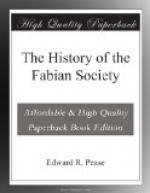“Facts for Londoners” was the work of Sidney Webb, but there is nothing in the tract to indicate this. The publications of the Society were collective works, in that every member was expected to assist in them by criticism and suggestion. Although several of the tracts were lectures or papers written by members for other purposes, and are so described, it was not until the issue in November, 1892, of Tract 42, “Christian Socialism,” by the Rev. S.D. Headlam, that the author’s name is printed on the title page. The reason for the innovation is obvious: this tract was written by a Churchman for Christians, and whilst the Society as a whole approved the conclusions, the premises commended themselves to but a few. It was therefore necessary that the responsibility of the author should be made clear.
The autumn of 1889 is memorable for the great strike of the London Dockers, which broke out on August 14th, was led by John Burns, and was settled mainly by Cardinal Manning on September 14th. The Fabian Society held no meeting between July 19th and September 20th, and there is nothing in the minutes or the Annual Report to show that the Society as such took any part in the historic conflict. But many of the members as individuals lent their aid to the Dockers in their great struggle, which once for all put an end to the belief that hopeless disorganisation is a necessary characteristic of unskilled labour.[23]
Arising out of the Dock Strike, the special demand of the Socialist section of trade unionists for the next four or five years was a legal eight hours day, and the Fabian Society now for the first time recognised that it could render substantial assistance to the labour movement by putting into a practicable shape any reform which was the current demand of the day.




